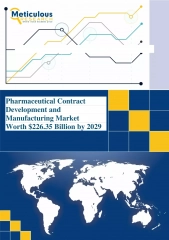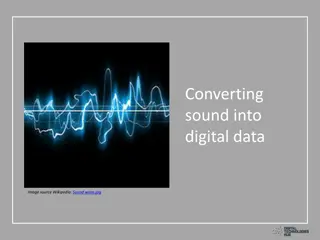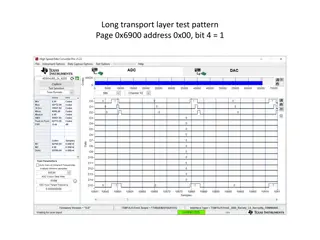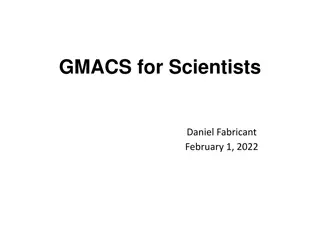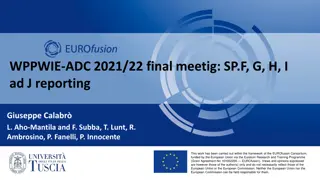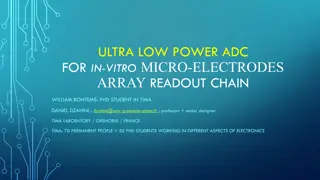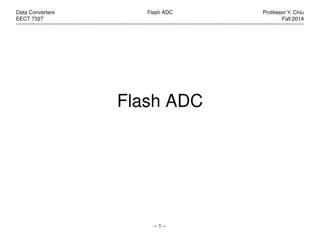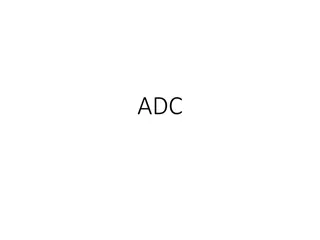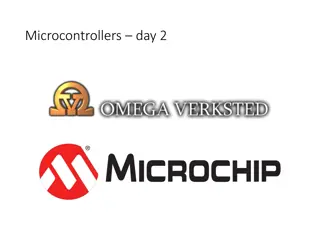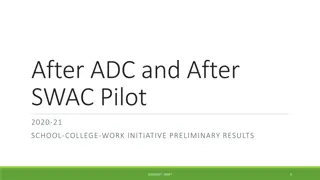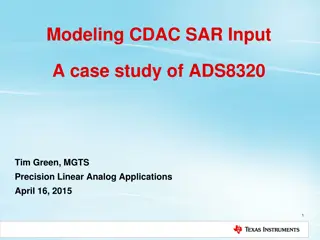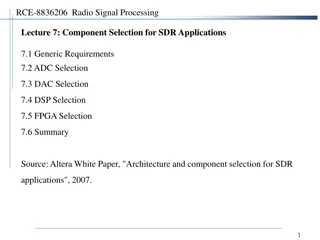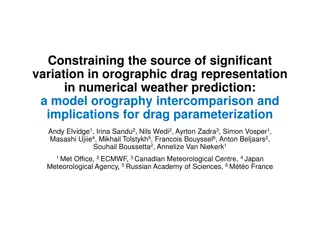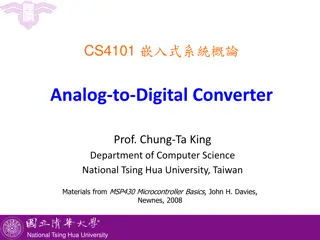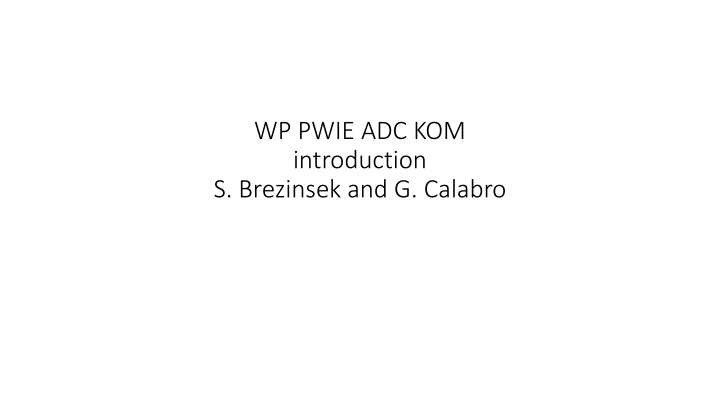
Plasma Modelling Activities for Advanced Divertor Concept Assessment
Explore advanced divertor concepts through plasma modelling activities for the DEMO project, focusing on comparing different ADC solutions and optimizing configurations using SOLPS-ITER. The goal is to enhance divertor performance and make informed decisions for the next level of optimization.
Download Presentation

Please find below an Image/Link to download the presentation.
The content on the website is provided AS IS for your information and personal use only. It may not be sold, licensed, or shared on other websites without obtaining consent from the author. If you encounter any issues during the download, it is possible that the publisher has removed the file from their server.
You are allowed to download the files provided on this website for personal or commercial use, subject to the condition that they are used lawfully. All files are the property of their respective owners.
The content on the website is provided AS IS for your information and personal use only. It may not be sold, licensed, or shared on other websites without obtaining consent from the author.
E N D
Presentation Transcript
WP PWIE ADC KOM introduction S. Brezinsek and G. Calabro
WP PWIE => DEMO input Initial ADC modelling and engineering assessment by 2022 (max. 2024 under discussion / include WP TE results about AUG top divertor After divertor decision strategy: transfer to WP DES (DCT) and WP DIV to next level of optimisation PWIE studies in TSVV7 with input from ADC / TE in charge of experiment exploitation I-DTT => divertor selection by the end of the year if present ENEA timeline prevails
Advanced Divertor Concept Capability Comparison SD ( ) SXD ( ) peak divertor heat load number of "control" coils Compare the merits of different ADC solutions to show a gain vs. reference SD (SND) peak divertor temperature 2,20 0,84 1,65 Proposal: utilise a spider diagram 4,2 RH compatibility degree of detachment 0,56 1,10 4,2 2,8 Identify most critical Physics Quantities Engineering Quantities Quantification type Hard numbers (e.g. impurity concentration) Soft information (e.g. RH compatibility) Comparison Always reference to SD Direct comparison between ADCs 4,2 2,8 0,55 0,28 2,8 1,4 1,4 1,4 required control power divertor radiation fraction 1,4 2,8 4,2 4,2 2,8 1,4 1,4 1,4 1,4 2,8 1,4 1,4 2,8 4,2 2,8 4,2 2,8 2,8 instability growth rate total radiation fraction 4,2 4,2 4,2 pumping rate divertor impurity concentration peak neutron flux Outcome: Comparison of ADC solutions along a clear set of criterions (if modelling available) No real numbers concept only
Plasma Modelling Activities for DEMO I Abandon in the moment development/tests of turbulence code => back to TSVV and TE (review end 2022) Focus on SOLPS-ITER usage + Optimisation tool Best explored advanced configurations: SD, XD, SXD SOLPS-ITER so far only with fluid neutrals and standard grid option: Update of SOLPS-ITER regarding wide-grid option and kinetic option (EIRENE) Benchmark against old best case for SD, XD, SXD => first input to TSVVs as case Benchmark experiments and modelling within WP TE Comparison of neutral modules regarding impact of neutrals and calculation speed (SD, XD, SXD) full fluid (improved) hybrid kinetic/fluid full kinetic options (same cases as above) Hand-over options to DIVGAS for pumping assessment Outcome: Clarification regarding missing x-point radiaton in fluid kinetic simulations Confidence in existing modelling (large matrix) => new runs with time/precision optimum SOLPS with EIRENE as input for PWI studies in TSVV 7
Plasma Modelling Activities for DEMO II Moderate exploration of hybrid configuration solutions / optimisation procedures between SD, XD, SXD Best suited SOLPS-ITER version (fluid neutrals?) to study configuration hybrid solutions: small matrix of runs: Ar / D2scan | check if physics benefits remain Hybrid between SN and XD (no existing) Hybrid between SN and SXD (exist / same inner target / different outer target) Apply iterative SOLPS-ITER optimisation technique to identify optimum solution regarding power handling and magnetic configuration realisation: target tile shaping, leg length, and magnetic shape (KU LEUVEN) Test run with target shaping SN or XD (separate) Test run with leg length between SN and SXD Test run with all optimisations combined Best cases could be analysed regarding engineering properties envelope already given / focus on optimisation (control power / vertical stability) Outcome: Optimisation with respect to baseline solution at low cost in change, but high impact Qualification of optimisation tool which can be applied to other ADC designs
DN / DND Less explored configuration regarding experiment / modelling Optimise modelling with improved SOLPS-ITER ? Include lessons learned from challenging experience with existing SOLPS-ITER runs for DND in EAST Clarify how to compare with other single divertor configurations regarding exhaust improvement? 2 identical divertors / oscillation? Comparison with existing experiments essential to assess (no) benefit found in first DEMO runs Assess control and stability issues for DEMO? Can the divertor be split and inner divertor remain for wall lifetime in? Outer divertor leg exchange separate? WEST as available European benchmark facility to gain data and experience? EAST /DIII-D / TCV? Combine experimental studies with control questions in long-pulse operation Currently physics issues as device with equivalent divertors (shape / pumping) rare Potential collaboration with new EAST W divertor experiments under revised EU-CHN partnership? Next step ADSDEX Upgrade COMPASS-U DTT? Requires WP TE and human resources on experimental and modelling side Dedicated project activity? Funding? Timescale
SFD / SF+ / SF- Less explored configuration regarding modelling SOLPS-ITER modelling seems very challenging for DEMO runs in SF Can we expect improvements with new SOLPS-ITER? TCV as available European benchmark facility with a lot of data Test with new SOLPS-ITER version for TCV or SOLPS-ITER predictions for ASDEX Upgrade Return to DEMO predictions if successful and stable (KU Leuven) Parallel on engineering side: clarify if there is any chance of realisation regarding control and coils Requires WP TE and human resources on experimental and modelling side Dedicated project activity? Funding? Timescale
I-DTT timeline and divertor selection The given timeline for the first divertor in I-DTT is (in my view) currently not compatible with the plan to test the BEST ADC solution for DEMO (within the EUROfusion program) Potential compromises / solutions a) The first I-DTT divertor if DTT in time - could be selected out of the mature SD, XD, SXD group SD would mean a conventional divertor, but maybe with advanced PFC/M concepts (other then ITER) A hybrid solution between SD and XD or SXD might be an option to follow with the first divertor showing some benefit over the SD (optimisation tool via SOLPS-ITER could be used) Validate the improvement and tools / not necessary the best DEMO solution This option rules out SFD and DN b) The first I-DTT divertor CONCEPT if DTT in time - could be a DN solution utilising an upper and lower divertor out of the mature SD, XD, SXD group or hybrids between them. One could use a SN reference lower divertor and an optimised upper hybrid SD-XD or SD-SXD divertor Allows to compare directly different divertor solutions and benefits including DN Note upper and lower divertor could be splitted in time for installation if we say it is a DN test This option rules out the SFD c) The first I-DTT divertor if delayed - could be selected out of a wider portfolio of concepts including SFD Which one to choose and when? What do we want to test for DEMO? Concept? PFCs? Stability? Scheme? Engineering?
Physics (including pumping) V TF stress analysis Control Neutronics 2018 2020 (port compatible) 2020 (morphed and port compatible) 2018 2020 (port compatible) 2020 (morphed and port compatible) 2018 2020 (port compatible) 2020 (morphed and port compatible) 2018 2020 (port compatible) 2020 (morphed and port compatible) 2018 2020 (port compatible) 2020 (morphed and port compatible) Hybrid 2020 SND V V V Already port compatible Generated by PMI V Generated by PMI DND V V X XD V V V V Already port compatible Not generated V X V V X V V SXD V NN NN V NN NN V V X V V V X V X V X X X X X SFD
Status Feature Potential benefit Configuration Longer connection length Larger collisionality and hence easier access to high-radiation and detached regimes, lower Ttarget, more room for radial transport. SXD; XD; SFD Larger poloidal flux expansion SXD (difficultin DEMO); XD Passive mechanisms), increased connection length and wetted area. stabilization of detachment front (via different Larger toroidal flux expansion SXD Multiple X-points Splitting of energy and particle fluxes to multiple targets, Stabilization of the radiation front outside the core, in SFD increased connection length, in DND topological separation of the inner divertor. DN; SFD
Disscusion from Joint Meeting of FTD and FSD (Zohm/Federici/Naulin/Brezinsek/Neu/Wischmeier/Wiesen/Maviglia ): ADC configuration issues (summarised by Hartmut): DN: show simultaneous control of two detached divertors (best, but not necessary: symmetric pumping and geometry, probably not by controlling drsep) at relevant heat flux in experiments devise modelling scheme that gives reliable comparison to SND and others (not really the case so far(?)) and quantify physics gain engineering: quantify (dis)advantages (vertical stability, TBR ) SFD: Get a converged code run to compare operational window Is it ruled out due to control problems (both SF+ and SF-)? Or deferred infinitely? SXD: Is there physics value to combine it with an XD (flux expansion at target)? What would be the impact on engineering (coils)? Strategy to validate the predicted gain in operational space (theory & experiments)?

